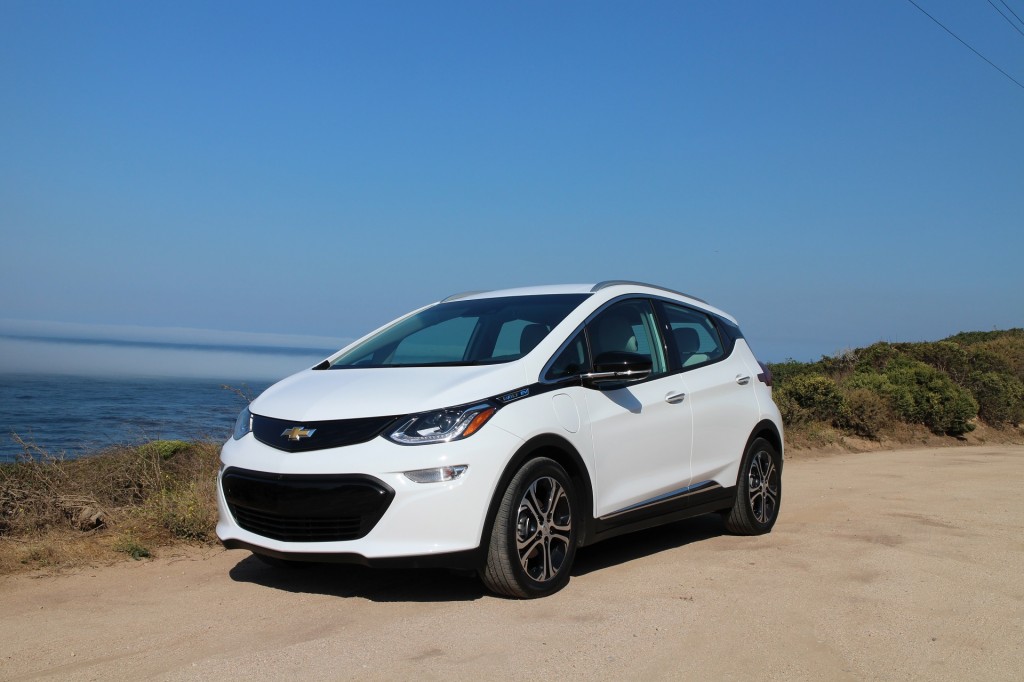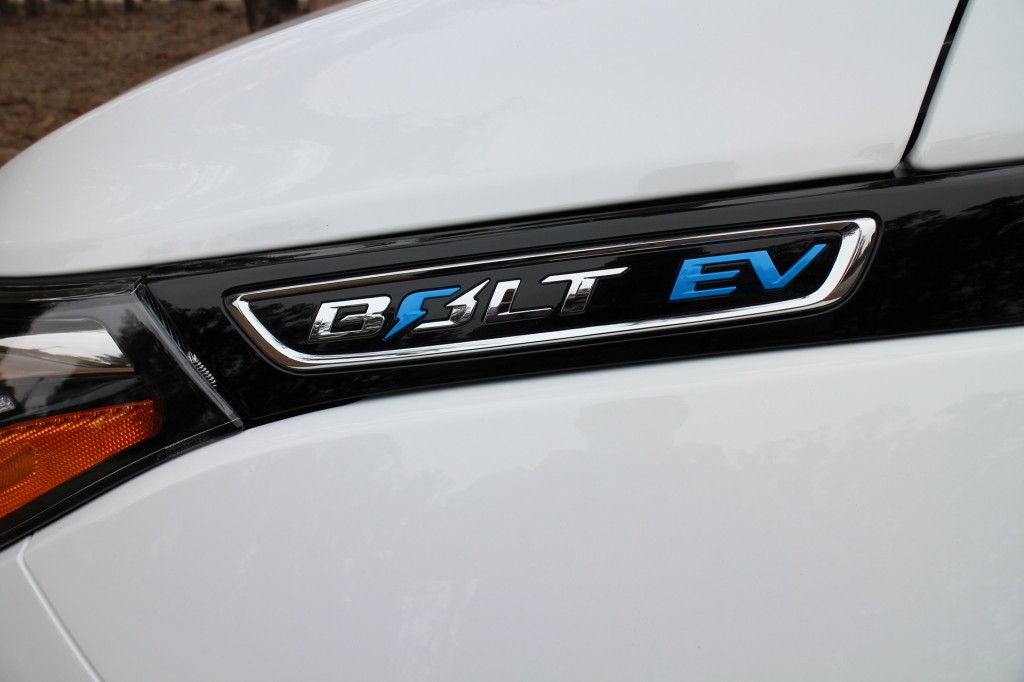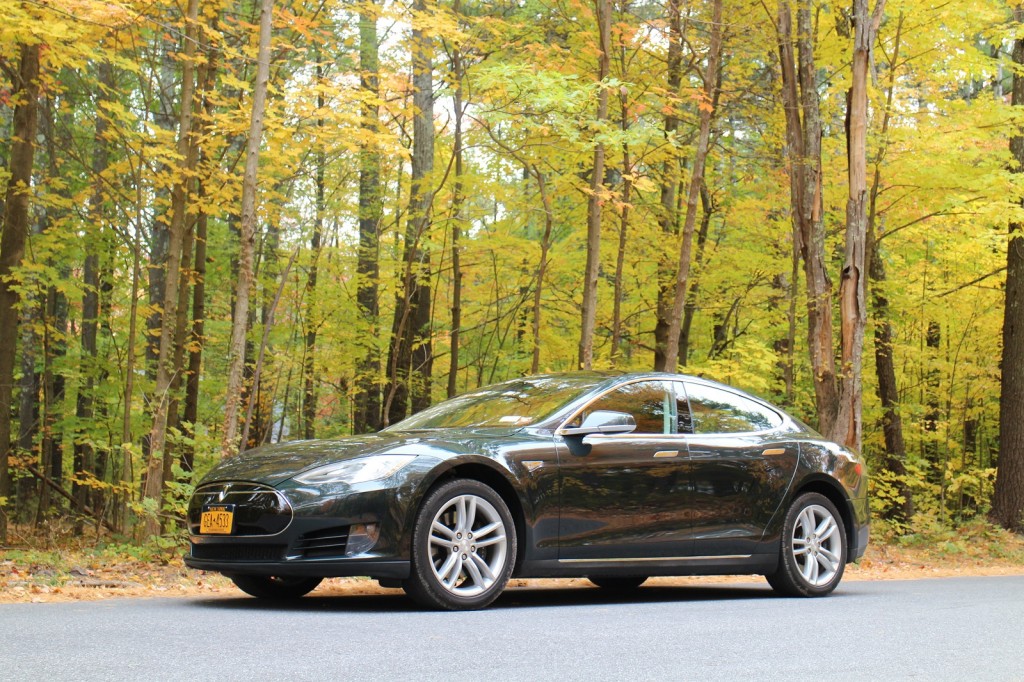
2017 Chevrolet Bolt EV, road test, California coastline, Sep 2016
Fleeing my home in New York’s Hudson Valley for California during February and March has a number of charms. Currently at the top of the list: reading about Winter Storm Stella while watching the surfers at Rincon Beach.
For electric-car nuts like me, however, there’s another California perk that’s not far behind: the wide availability of the Chevy Bolt.
Back home, I’d been hankering for a Bolt test drive for months. As a long-time Tesla Model S owner, I was eager to see how it compared to the gold standard of electric cars.
DON'T MISS: Chevrolet Bolt EV: Green Car Reports' Best Car To Buy 2017
But several calls to nearby Chevy dealers had come up empty. No Bolts until April at the earliest, I was told. Sorry.
Once arrived in California, however, a quick call to Bunnin Chevrolet in Santa Barbara hit paydirt: “Sure, come on over any time. We’ve got a bunch of them.”
And so they did. Seven or eight Bolts were lined up right in front of the main entrance when I arrived. These guys, unlike most car dealers back East, apparently did not consider electric cars to be unsaleable orphans relegated to the back corner of the lot.

2017 Chevrolet Bolt EV, road test, California coastline, Sep 2016
It turns out that Bunnin’s sales manager drives a Volt that he powers with solar panels on his roof.
And the salesman who accompanied me on my test drive also owns a Volt. “I used to be a total motorhead,” he tells me. ”But now it just kills me to burn gas.”
Car salesmen who love electric cars? Wow. This really is La La Land.
READ THIS: 2017 Chevy Bolt EV electric car: new owner's first impressions
Easy In
First thing I noticed about the Bolt was how easy it is to get into.
My major beef about the Model S is the too-small front door. For tall guys like me, who put the seat all the way back, getting in requires an awkward move around the B-pillar, which to my thinking is about 3-4 inches too far forward.
The Bolt, by contrast, has a nice wide driver’s door. And the higher ride height makes it even easier to climb in.

2017 Chevrolet Bolt EV
Smaller car, bigger door. Chevy’s doing something right.
The Bolt’s touch screen is no match for Tesla’s dazzler, of course. But it’s not bad.
The Bolt’s screen can display a lot of information the Tesla can’t. Energy usage, for example, can be broken down among driving, climate control, audio system, and battery conditioning. Individual tire pressures can be displayed. Tesla has some catch-up to do here.
CHECK OUT: Why I canceled my Chevy Bolt EV electric-car order: a reader explains
There’s no Nav system in the Bolt, but it’s easy to simply hook up your smart phone and navigate on it through the car’s screen and speakers. Still, I missed that gorgeous 17-inch map display I’ve become accustomed to in the Model S.
The Bolt has one clever gimmick that the Tesla lacks: a rear-view camera that projects through the rear-view mirror.
Unlike the Tesla, the Bolt has one of those antiquated oddities, the On /Off button. Amazingly, no other manufacturer has adopted Tesla’s brilliantly simple idea that the car turns itself on when there’s a butt in the driver’s seat and a foot on the brake pedal. And turns itself off when the butt is removed.

2017 Chevrolet Bolt EV, road test, California coastline, Sep 2016
The Bolt has a conventional center console-mounted shift lever. But the Park mode, which involves various buttons and levers, is needlessly fussy. The Tesla, by contrast, uses a Mercedes column-shift lever that is boringly simple: Move the lever to P. Duh.
Surprising Space
Although the front seat area doesn’t feel as roomy as the Model S, the rear seats are surprisingly spacious.
Sitting in the back seat of my Model S, my knees brush the back of the driver’s seat when it’s set for my 6-foot-2 frame. But in the Bolt, I had several inches clearance.
Similarly, my head brushes the ceiling in the back seat of the Tesla, but not in the Bolt.
Smaller car, roomier back seat. Chevy has done a superb job of space engineering in the Bolt.
Burning Rubber
The Bolt is a blast to drive.
Although of course not up to Model S standard, the Bolt has excellent acceleration. Official 0-60 time is 6.5 seconds, better than any non-Tesla electric car, including the BMW i3. And 0 to 30, the Bolt feels like it could hang in there with some pretty heavy ICE iron.
A couple of times, I inadvertently chirped the tires—without even flooring the pedal.

2017 Chevrolet Bolt EV
Like its predecessor (and now stablemate) the Volt, the Bolt has a Sport mode that increases throttle response, making the car feel even livelier. Nothing like that in the Tesla.
With all this low-end torque and front-wheel drive, you’d expect some significant torque steer—the tendency of the car to veer right under sudden acceleration. But I noticed very little torque steer in the Bolt—unlike a friend’s high-performance Mini Cooper, which practically yanked the steering wheel out of my hand when I floored it.
The Tesla, with rear-wheel or all-wheel drive, of course tracks straight and true under even the most extreme acceleration.
On the road, the Bolt has a solid, stable feel. Again, not up to the standard of the Model S, which after all has a much longer wheelbase and weighs a half-ton more. But the Bolt feels far more solid than the twitchy, jittery i3, which is of comparable size.
I was entirely comfortable cruising along the 101 Freeway at 75 mph, mixing it up with some fairly heavy and aggressive traffic.

President Barack Obama sits in 2017 Chevrolet Bolt EV electric car at Detroit Auto Show, Jan 2016
Strong Regen
In the normal D mode, the Bolt has mild regenerative braking that makes it feel pretty much like a standard ICE car. But shift to L, and you get some serious regen, comparable to the Tesla’s.
The Volt has a similar regen system, and during my three-year stint as a 2011 Volt owner, I always, always selected L mode. I’d do the same in the Bolt.
Unlike the Tesla, the Bolt in L mode has no “idle creep” option. The car simply comes to a complete stop with foot off the gas.
For even more regen on demand, the Bolt has paddles behind the steering wheel. They may work okay in D mode, but in L mode—high regen already—I could barely tell the difference when the paddles were activated.

2013 Tesla Model S owned by David Noland, Catskill Mountains, NY, Oct 2015
In the Model S, by contrast, regen is blissfully simple: as soon as you buy the car, you select “normal” regen on the touchscreen (as opposed to “low”) and never think about it again.
In terms of efficiency, the Bolt beats my 85-kWh Tesla by about 20 percent, according to the EPA. (119 MPGe vs. 89.) My drive was too short to generate an accurate efficiency figure, but Green Car Report’s earlier 240-mil test drive of the Bolt in California registered 4.1 miles per kWh.
Under similar conditions, my Tesla averages about 290 watt-hours per mile, which translates to about 3.4 mi/kWh. So that 20-percent EPA advantage appears to hold up in the real world.

2017 Chevrolet Bolt EV, road test, California coastline, Sep 2016
Better than a Model 3?
With its $35,000-ish price tag and 238-mile range, the Bolt has instantly made all other non-Tesla electric cars obsolete.
It’s now hard to imagine why anyone would buy a Leaf, i3, e-Golf, or any other current electric car. (Maybe $15,000 cash on the hood? I actually feel kind of sorry for all the other e-car manufacturers and dealers.)
The Bolt is so good that, on paper, it will challenge Tesla’s upcoming Model 3, which will have the same price tag, and a range that has so far only been promised to be “at least 215 miles.” (Although I’m sure Elon is now doing everything humanly possibly to get it up to 240.)
Will many of the 400,000-odd people who’ve put down deposits on the Model 3 switch to a Bolt tomorrow rather than wait a year or two for their Model 3?
That remains to be seen, but I doubt it.
![Tesla Supercharger network, North American coverage map, Feb 2017 [graphic: Isaac Bowser] Tesla Supercharger network, North American coverage map, Feb 2017 [graphic: Isaac Bowser]](https://images.hgmsites.net/lrg/tesla-supercharger-network-north-american-coverage-map-feb-2017-graphic-isaac-bowser_100591618_l.jpg)
Tesla Supercharger network, North American coverage map, Feb 2017 [graphic: Isaac Bowser]
No Superchargers
Beyond the cachet of the Tesla brand, the Bolt has one major flaw compared to the Model S and Model 3: the lack of a long-distance DC fast-charging network.
The difficulties recounted in these pages last week by a new Bolt owner trying to make a long-distance trip were a sobering reminder of the primitive state of long-distance DC charging for non-Tesla cars.
COUNTERPOINT: Chevy Bolt EV: 800-mile trip in 238-mile electric car shows challenges remain
It will take many years and hundreds of millions of dollars to match Tesla’s current Supercharger system, which makes long-distance travel practical virtually everywhere in the country.
And at this point, neither Chevy nor anyone else seems to be making a serious effort to even start such a network.
And then there’s the Bolt’s almost total lack of self-driving capability. While the Model 3 may well have some autonomous driving capabilities under certain circumstances by the time it gets into mass production, the Bolt is missing even a basic requirement for future autonomy: adaptive cruise control. (Chevy is currently testing fully autonomous Bolts, so that may soon change.)

2017 Chevrolet Bolt EV
Bottom line
I loved the Bolt. Like its predecessor the Volt, it’s a terrific car.
But a Tesla it ain’t. No chance I’ll trade in my Model S for a Bolt, or cancel my Model 3 reservation (which is actually a placeholder for the promised Model Y crossover version.)
There’s no shame in the Bolt falling short of the Model S, which costs twice as much.
But despite the Bolt’s breakthrough combination of range and price, the Model 3’s brand cachet, sleek styling, superior performance, long-distance charging, and potential for autonomous capability will eventually make it the clear winner, in my view.
Eventually. But if I were well down the Model 3 reservation list, with little hope of getting mine in the next 18-24 months—and virtually no hope of getting the $7,500 tax credit—I’d seriously consider buying a Bolt right now to tide me over.
EDITOR'S NOTE: An earlier version of this article suggested that "the Model 3 may well have full level 5 autonomy by the time it gets into mass production" and that neither lane-keeping alerts nor automatic emergency braking were available on the Bolt EV. Both those statements are inaccurate. Level 5 autonomy is essentially the ability for a car to take occupants to any destinations they specify, under any circumstances, while they sleep. Or, as one commenter calls it, "blind people driving." That ability is widely acknowledged to be at least several years in the future, with most experts pegging it for 2030 or thereabouts, though Tesla believes it can deliver earlier than that. Also, while adaptive cruise control is not offered on the Bolt EV, lane-keeping alerts and automatic crash braking are available as options. Green Car Reports regrets the errors.
_______________________________________












